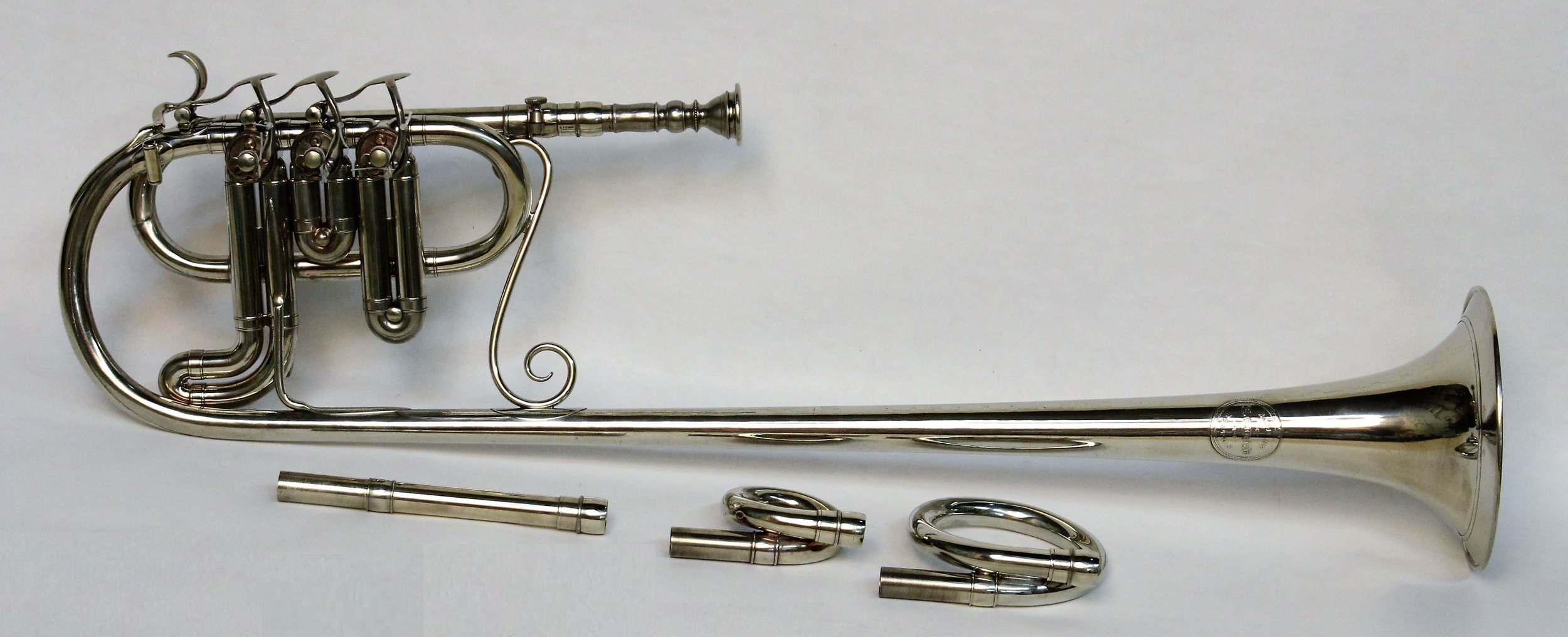Early Bb and C Cornets by E.G. Wright
These two Bb cornets by E.G. Wright appear the same at first glance, but there are some very interesting and intriguing differences found on closer examination. I probably have more questions than answers about the details of these cornets and I can't even tell you which is the older instrument, although I quite confident that they were both made between 1855 and 1863. If I were to guess, I would say that the medallion indicates the earlier instrument (from the collection of Steve Ward) and was likely made around 1860, possibly earlier.
Earlier Bb cornet by E.G. Wright with shank for A and crooks for Ab and G.
The engraved bell markings on the other cornet (from the collection of Mark Elrod) are very much like those seen on Wright instruments known to have been made in the later 1860s, when "& Co." was included in the engraving and those made by Boston Musical Instrument Manufactory after that. The "& Co." indicates the inclusion of Henry Esbach and Louis Hartmann in more important roles in the shop than they previously had as well as the final consolidation with Graves & Co. that had been maintaining a separate business in the same shop.
Right side of later Bb cornet by E.G. Wright.
They are both about the same over all length at 23 7/8" and bore measurement: .456". The later instrument has a larger bell, approaching those of Saxhorns and the bell rim diameter is 5 3/16". After taking careful measurements, I was able to determine that it was likely made on the same bell mandrel and Wright used for his very popular Eb sopranos, although those have rim diameters close to 4 1/2".
Left side of later cornet by E.G. Wright.
The earlier bell diameter is 4 3/4" and the taper and flare are more like French cornet bells, although still larger than the Courtois copy bells that Wright was known to make later and Graves & Co. was already making by this time. Unusual for cornets with bells over the shoulder, which were designed to be used in military bands, it has a shank and crooks for playing in the lower pitches of A, Ab and G. The only attachment extant with the instrument when found was that for Ab, the rest were reconstructed based on that and the mouthpiece, which is obviously original. We are lucky that both of these instruments survived with original mouthpieces, the earlier being longer, but with similar cup and rim to the later.
Left side of earlier Bb cornet by E.G. Wright.
Another Bb cornet by Wright is illustrated below and has also survived with its original mouthpiece and crook to G. In this form, it is not surprising to have the capability to play in the lower keys and these were often called "orchestra cornets" by the Boston makers. In this case, however, the mouthpiece has a pronounced bowl shaped cup, with a fairly sharp transition to the throat, typical of trumpet mouthpieces from the era, indicating that this instrument was likely intended for use in a symphonic rather than dance orchestra or military band. I wouldn't be surprised, however, if Wright had supplied the original player of this instrument with both trumpet and cornet style mouthpieces, although we will never know for sure. This instrument went though my shop in the 1980s, and it didn't occur to me to record the bell and bore measurements. It is now in the collection of the Musical Instrument Museum in Phoenix, Arizona. As you can see, it has the same round name shield as the presumed earlier example with bell over the shoulder. It also has the same unusual design of the shank and crooks which incorporates a sliding receiver with clamp screw and mouthpiece with a short but very large diameter shank.
Trumpet or orchestra cornet made by E.G. Wright about 1860.
More recently, another instrument with the same round shield by Wright was found by Mark Elrod that also incorporates the same system of shank and crooks. Very unusual, is that this one combines the larger Saxhorn bell, the same as the later cornet, in a bell front cornet in C. It survives with original mouthpiece and original shank and crooks for Bb, A, Ab and G. My opinion is that these large cornet mouthpieces show the Germanic influence of Esbach and Hartmann, as well as the Huttl brothers that worked there at the time. German rotary valve cornets continued to have large shank mouthpieces that fit into mouthpipes with little or no taper well into the 20th century and most of the German and Austrian imports to the US with rotary valves until about the 1880s had the same.
Wright orchestra cornet in C with crooks for Bb, A, Ab and G.
E.G. Wright (& Co.) saw the increasing dominance of the French (Courtois and Besson) Bb cornets that was well underway before 1860, and by 1865 were making rotary valve versions of them. With so little data, I can't know any more precisely, but I wouldn't be surprised if Wright started making the French style cornet bells along with the Saxhorns well before 1860, as I now know that his shop mates Graves & Co. were doing.
Boston Musical Instrument Manufactory continued to offer all sizes of their rotary valve instruments with bells over the shoulder, from Eb soprano to Eb contrabass until at least the mid-1870s, but they were falling out of fashion by that time. Cornets with bells forward and all larger instruments with bells upright continue to be the most common to this day.
Boston Musical Instrument Manufactory catalog from 1869.








